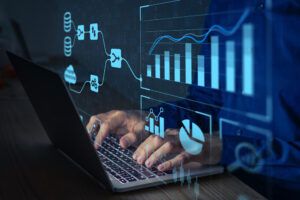Zero Trust Architecture: Top 5 Ways to Boost Cyber Resilience

Zero trust architecture is rapidly transforming the cybersecurity landscape in more ways than one. As organizations grapple with an ever-evolving array of cyberthreats, this innovative approach has emerged as a beacon of hope. This is especially true when you consider how traditional security measures often fall short in our interconnected digital world. Therefore, the need for more robust and adaptive solutions becomes evident. Zero trust architecture, by adopting the principle of “never trust, always verify”, provides a proactive response. Consequently, it ensures that every user, device, and process undergoes thorough authentication and authorization. So, why is this architecture gaining such traction, and how does it reinforce cyber resilience?
In this blog, you will learn:
- What is Zero Trust Architecture and How Does It Work?
- How Does Zero Trust Architecture Contribute to Cyber Resilience?
- What are the Key Components of Zero Trust Architecture?
- How Can Organizations Implement Zero Trust Architecture Effectively?
- Take the Next Step in Cybersecurity With Emeritus
 What is Zero Trust Architecture and How Does It Work?
What is Zero Trust Architecture and How Does It Work?
Zero trust architecture is a strategic approach to cybersecurity that operates on a simple yet profound principle: “Never trust, always verify”. Instead of relying on traditional security models that implicitly trust everything within an organization’s network, zero trust eliminates this implicit trust. It continuously validates every digital interaction, ensuring that every user, device, and process is authenticated and authorized.
Historically, once users, including potential threat actors, gained access to a network, they could move laterally due to a lack of granular security controls. However, zero trust architecture challenges this outdated assumption. By leveraging robust authentication methods, network segmentation, and layer 7 threat prevention, which refers to the security measures applied at the application layer (Layer 7 of the OSI model) to ensure that only authenticated and authorized users and devices can access specific network resources, regardless of their location or network connection, it ensures that users have the “least access” necessary, thereby minimizing risks.
How Does Zero Trust Architecture Contribute to Cyber Resilience?
1. Prevention of Data Breaches
Zero trust architecture plays a pivotal role in minimizing the risk of data breaches. By implementing multiple layers of security control, it adds depth to defense mechanisms. Furthermore, by continuously validating every interaction, zero trust ensures that any unauthorized access is not only detected but also promptly prevented, safeguarding sensitive data.
2. Elimination of Implicit Trust
Traditional security models have often suffered from the pitfall of implicit trust. Zero trust, in contrast, takes a proactive stance. It ensures that trust is never assumed and always verified, thereby adding an extra layer of protection that fortifies the digital perimeter.
3. Enhanced Protection for Modern Environments
As the digital landscape evolves, so do the challenges. With the rise of hybrid workforces and cloud migrations, securing modern environments has become more crucial than ever. This cybersecurity architecture, therefore, is tailor-made for these scenarios; it offers robust protection against potential threats, ensuring that data remains secure regardless of where it resides.
4. Reduction in Security Complexity
While zero trust undeniably enhances security, it also simplifies it. By focusing on critical assets and streamlining policies, it reduces operational overhead. As a result, organizations can maintain a strong security posture without getting bogged down by complexities.
5. Adaptability to Changing Threat Landscapes
The cyberthreat landscape is dynamic and ever-evolving. Consequently, zero trust architecture, with its continuous verification approach, ensures that organizations remain resilient, adapting swiftly to new and emerging threats.
ALSO READ: Cybersecurity Risk Management: Top 5 Ways to Mitigate Potential Threats
What are the Key Components of Zero Trust Architecture?
1. Strong User Authentication
At the very core of zero trust lies the authentication of user identity. Ensuring that every user is genuinely who they claim to be, effectively prevents unauthorized access and safeguards critical assets.
2. Application Trust Levels
Applications in the digital realm are abundant. Zero trust, therefore, treats applications with a healthy dose of skepticism. It not only removes implicit trust but also diligently monitors applications at runtime to validate their behavior, ensuring they operate within expected parameters.
3. Infrastructure Security
From the foundational routers and switches to expansive cloud environments, every aspect of an organization’s infrastructure is meticulously secured under this architecture. As a result, potential vulnerabilities are identified and addressed, fortifying the entire network.
4. Device Verification
Beyond just users and applications, the integrity of devices is paramount. Zero trust, recognizing this, verifies the integrity of devices, ensuring they remain uncompromised and function as intended.
5. Data-Centric Policies
Data, undeniably, is often the primary target in cyberattacks. Therefore, zero trust places a significant emphasis on data protection, ensuring that sensitive information, whether at rest or in transit, remains secure and inaccessible to malicious actors.
ALSO READ: Staying Ahead of Cyberthreats: 5 Latest Trends and Best Practices
How Can Organizations Implement Zero Trust Architecture Effectively?
1. Identify Critical Assets
The journey to implementing zero trust begins with pinpointing the most valuable data, assets, and applications. By doing so, organizations can prioritize their security efforts, focusing on what truly matters.
2. Understand User Behavior
Understanding the intricacies of user behavior is essential. By gaining insights into who the users are and how they interact with the network, organizations can craft and enforce effective security policies that resonate with real-world scenarios.
3. Implement Strong Authentication Methods
Authentication is the gateway to access. Therefore, using multifactor authentication and other robust methods ensures that only authorized individuals gain access, keeping potential intruders at bay.
4. Continuously Monitor and Adapt
One of the core tenets of zero trust architecture is continuous monitoring and adaptation. This means that organizations should not only verify identities and permissions at the initial point of access but continuously monitor sessions and adapt security postures based on behavior and other contextual factors. In essence, under this security framework, trust is never static; it’s continuously evaluated and adjusted based on real-time data and insights.
5. Educate and Train Employees
The human element cannot be overlooked: It’s essential to ensure that all employees, from top-tier executives to entry-level staff, are aware of principles and best practices related to zero trust architecture. Regular training sessions can significantly bolster security, creating a culture of awareness and vigilance.
ALSO READ: 10 Great Reasons Why Professionals Should Learn Cybersecurity
 Take the Next Step in Cybersecurity With Emeritus
Take the Next Step in Cybersecurity With Emeritus
Clearly, zero trust architecture is not just a buzzword; it is a necessity in today’s digital world. By understanding and implementing its principles, organizations can significantly enhance their cyber resilience. If you’re keen on diving deeper into cybersecurity and exploring more advanced concepts, consider checking out these cybersecurity courses offered by Emeritus. Equip yourself with the knowledge and skills to navigate the complex world of cybersecurity.
Write to us at content@emeritus.org




